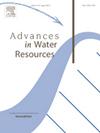Acropora coral pore morphology and its internal hydrodynamics
IF 4
2区 环境科学与生态学
Q1 WATER RESOURCES
引用次数: 0
Abstract
Pore networks are the pivotal channel for mass transport within Acropora corals, enabling coral’s reef-building capabilities in their marine ecosystems. The interactions of the coral with its surrounding water can be described as a complex hydrological system where the exchange of fluids transporting different agents is constantly occurring. Despite being of critical importance, there is a lack of modeling frameworks to represent coral’s pore structure and how it interacts with the outside. In this paper, combining micron-scale computed tomography (micro-CT), image processing, and lattice Boltzmann fluid simulations, we determine the preliminary pore scale hydraulic properties based on one single branch. Also, we quantify the anisotropy of the skeleton permeability tensor by using Darcy’s law at low Reynolds numbers. Consistently, the methods we used provide evidence for a tree-like structure, which governs the internal flow to spread across the coral, maximizing the residence time of solutes. We also compared the skeleton’s inner pore structure with the terrestrial trees’ growth region, aiming to identify the structural and functional similarities that could enhance the understanding of the coral branch’s morphology and functional roles. Our work gives a novel perspective to characterize the internal hydraulic properties of the skeleton, which enhances the understanding of nutrient transport during coral growth and facilitates further biomimetic applications in coastal defense designs.

鹿角珊瑚孔隙形态及其内部水动力学
孔隙网络是Acropora珊瑚内部物质运输的关键通道,使珊瑚在其海洋生态系统中具有造礁能力。珊瑚与其周围水域的相互作用可以被描述为一个复杂的水文系统,在这个系统中,运送不同物质的流体交换不断发生。尽管珊瑚的孔隙结构至关重要,但目前还缺乏模型框架来表示珊瑚的孔隙结构及其与外界的相互作用。本文结合微米尺度计算机断层扫描(micro-CT)、图像处理和晶格玻尔兹曼流体模拟,初步确定了基于单个分支的孔隙尺度水力特性。此外,我们还利用达西定律在低雷诺数下量化骨架渗透率张量的各向异性。一致地,我们使用的方法为树状结构提供了证据,这种结构控制着珊瑚内部流动,从而最大限度地延长了溶质的停留时间。我们还将其骨架的内部孔隙结构与陆地树木的生长区域进行了比较,旨在找出结构和功能上的相似性,从而增强对珊瑚分支形态和功能作用的理解。我们的工作提供了一个新的视角来表征骨骼的内部水力特性,这增强了对珊瑚生长过程中营养物质运输的理解,并促进了在海防设计中的进一步仿生应用。
本文章由计算机程序翻译,如有差异,请以英文原文为准。
求助全文
约1分钟内获得全文
求助全文
来源期刊

Advances in Water Resources
环境科学-水资源
CiteScore
9.40
自引率
6.40%
发文量
171
审稿时长
36 days
期刊介绍:
Advances in Water Resources provides a forum for the presentation of fundamental scientific advances in the understanding of water resources systems. The scope of Advances in Water Resources includes any combination of theoretical, computational, and experimental approaches used to advance fundamental understanding of surface or subsurface water resources systems or the interaction of these systems with the atmosphere, geosphere, biosphere, and human societies. Manuscripts involving case studies that do not attempt to reach broader conclusions, research on engineering design, applied hydraulics, or water quality and treatment, as well as applications of existing knowledge that do not advance fundamental understanding of hydrological processes, are not appropriate for Advances in Water Resources.
Examples of appropriate topical areas that will be considered include the following:
• Surface and subsurface hydrology
• Hydrometeorology
• Environmental fluid dynamics
• Ecohydrology and ecohydrodynamics
• Multiphase transport phenomena in porous media
• Fluid flow and species transport and reaction processes
 求助内容:
求助内容: 应助结果提醒方式:
应助结果提醒方式:


